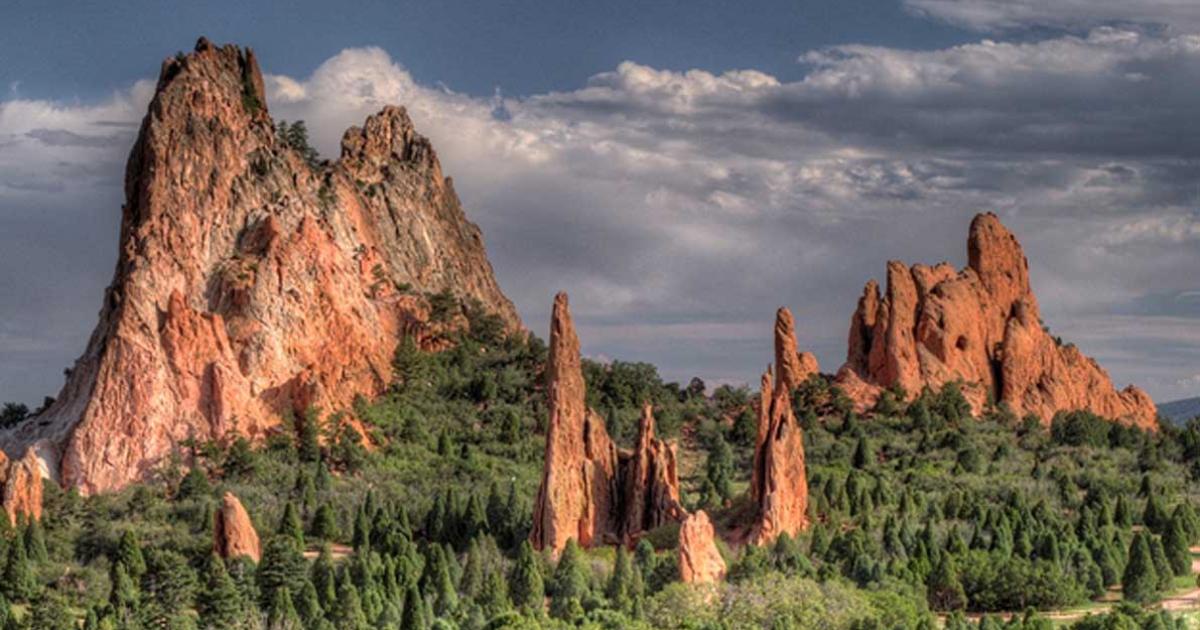
Garden of the Gods: Sacred Ground and Native American Crossroads
Located in Colorado Springs, the Garden of the Gods is a stunning expanse of unique geological formations. Its known human history goes back around 3,000 years, however, the indigenous Ute people claim their ancestors always lived there. Over the centuries, the spectacular landscape served as a Native American crossroads with numerous nomadic tribes gathering there in peace. According to local stories, the immense sandstone formations were considered sacred ground and that meant that even rival tribes laid down their weapons when entering the Garden of the Gods.
In 2014, the Garden of the Gods was voted Top Park in the United States and is frequently listed on global ‘most visited parks’ lists- over one million guests a year journey to this National Natural Landmark. The park’s interesting name came from two surveyors who visited the park in 1859 while working on establishing Colorado City. One of the men, M.S. Beach commented that he thought the site would be a “capital place for a beer garden”. His companion, Rufus Cable, replied “Beer Garden! Why it is a fit place for the gods to assemble. We will call it the Garden of the Gods.”
Owned by the City of Colorado Springs, the Garden of the Gods was established in 1909 as a nature preserve of 240 acres. Today, the park includes 1,387 acres. The park is situated at a distinctive geographic location – it is where the grasslands of the Great Plains begin to merge with the pinon-juniper woodlands of the American Southwest and the mountain forests of the Rocky Mountains. This creates a vibrant array of plants and animals; however, most of the tourists come to see the rocks, not the birds.
Rock Formations
The characteristic rock formations of the Garden of the Gods were formed over a million years ago by naturally occurring geological upheaval. The park is situated on part of the Trans-Rocky Mountain Fault System, the same fault lines that contributed to the formation of the Rocky Mountains and the Pikes Peak massif. Ancient sedimentary beds of sandstone, conglomerates, and limestone were originally deposited horizontally. However, as the tectonic plates pressed together, the rocks were tilted vertically and shaped into ‘fins’ because of the immense force. The red, pink, and white rock formations would have remained ordinary mountain and cliff faces if it were not for the subsequent eroding forces of the receding glaciers at the end of the Pleistocene Ice Age.
- Blythe Intaglios: The Impressive Anthropomorphic Geoglyphs of the Colorado Desert
- Orion Temple in Colorado - Part 1

The formation known as the Three Graces (CC BY-SA 3.0)
Water currents and strong winds eroded the rocks into their current statuesque appearance. These same forces pushed around and toppled the rocks, helping to create the individual arrangements that are so picture-worthy, for example, the famed Balanced Rock. Still, hints of ancient histories can be seen in the rocks, including former seas and beaches, massive mountain ranges, and huge fields of sand dunes.

The Balanced Rock (CC BY-SA 3.0)
In addition to geological history, the Garden of the Gods showcases human history, too. There is evidence that prehistoric humans visited the park as early as 1330 BC, including petroglyphs, ancient fire rings, broken pottery, and innumerable stone tools and projectile points. Around 250 BC, a tribe of Native Americans began to camp in the park; they were most likely attracted to the site for its abundance of animal and plant life as well as the shelter provided by the rock over-hangs. Doubtless, they too were struck by the exquisite beauty of the landscape.
- Breaking Sacred Ground: The Confluence, and Disruption of the Balance of Origin Sites
- More than 1,500 Petroglyphs, including a Solar Calendar, Found in Northern Arizona
The Ute People
Many local tribes have claimed a connection to the Garden of the Gods at some point in time, including the Apache, Kiowa, Pawnee, Arapaho, Cheyenne, and the Shoshone; however, it is the Ute people who seem to have the greatest connection to the place. They mostly stayed near the Manitou Springs and inter-mountain trail now known as Ute Pass. They believed that the red rocks had spiritual properties and their oral tradition describes how man was created in the Garden of the Gods. Today, early Ute petroglyphs can be seen on some of the rocks. Europeans, mainly Spanish explorers, first arrived in the Garden in the 16th century.

Rising out of Ute pass (Public Domain)
The Garden of the Gods first became a park, of sorts, in 1879 when the founder of Colorado Springs, General William Jackson Palmer, convinced his friend, Charles Elliott Perkins, to purchase the 240 acres containing some of the most stunning portions of the Garden of the Gods. Perkins then doubled his initial purchase in 1899 and told General Palmer, who had donated over 1,000 acres of his personal property to the state of Colorado, about his intention to donate the land to the City of Colorado Springs. Unfortunately, Perkins died before he could see his dream of a Garden of the Gods public park. Yet, knowing well their father’s intention, Perkins’ children deeded the property to the city on December 22, 1909. They added the caveat that it had to remain free for the entire world to enjoy.
Today, the Garden of the Gods Park is a popular site for hiking, bike riding, rock climbing, and horseback riding.
Top image: Late afternoon in Colorado Springs. Photo Source: (Flick/CC BY 2.0)
Sources:
Colorado Springs. "Garden of the Gods in Colorado Springs." Garden of the Gods Colorado Springs. Colorado Springs, 2016. Web. 08 Nov. 2016. http://www.visitcos.com/garden-gods-colorado-springs
Garden of the Gods Visitor Center. "Step Back in History." Garden of the Gods. Garden of the Gods Visitor Center, 2015. Web. http://www.gardenofgods.com/park-info/park-2/park-history
Pikes Peak Country Attractions. "About Garden of the Gods." Pikes Peak About Garden of the Gods. Pikes Peak Country Attractions, 2016. Web. 08 Nov. 2016. http://www.pikes-peak.com/about-garden-of-the-gods/















